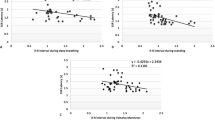Abstract
The neurophysiological mechanisms of convulsions were studied in the stammering syndrome. Electrophysiological, neurological, neuropsychological, and logopedic examinations were performed for 23 children aged 9–10 years with stammering. For comprehensive analysis, a neurophysiological classification was used to divide the stammering children into two groups: group I, which included patients with paroxysmal patterns recorded in the EEG, and group II, which included patients without paroxysmal EEG patterns. The analysis revealed a correlation of specific features of the autonomic regulation with the character of convulsions. Predominant malfunction of the parasympathetic part of the autonomic nervous system and tonic convulsions in stammering were found in the group I children. Malfunction of the sympathetic part of the autonomic nervous system and clonic convulsions in stammering were characteristic of group II children.
Similar content being viewed by others
REFERENCES
Shklovskii, V.M., Zaikanie(Stammering), Moscow, 1994.
Shklovskii, V.M., Lukashevich, I.P., Machinskaya, R.I., et al., Pathogenetic Mechanisms of Stammering, Zh. Nevrol. Psikhiat. im. S.S. Korsakova, 2000, no. 4, p. 50.
Shklovskii, V.M., Lukashevich, I.P., Machinskaya, R.I., et al., Pathogenetic Classification of Stammering, Zh. Nevrol. Psikhiat. im. S.S. Korsakova, 2000, no. 8, p. 67.
Lukashevich, I.P., Machinskaya, R.I., Shklovskii, V.M., et al., Comprehensive Analysis of the Pathogenetic Mechanisms and Etiology of the Stammering Syndrome, Defektologiya, 2000, no. 5, p. 9.
Sudakov, K.V., Sistemnye mekhanizmy emotsional'nogo stressa(Systemic Mechanisms of Emotional Stress), Moscow, 1981.
Zhirmunskaya, E.A., Klinicheskaya elektroentsefalografiya (Clinical Electroencephalography), Moscow, 1991.
Latash, L.P. Gipotalamus, prisposobitel'naya aktivnost' i elektroentsefalogramma(Hypothalamus, Adaptive Activity, and Electroencephalography), Moscow: Nauka, 1968.
Luria, A.R., Osnovy neiropsikhologii(Fundamentals of Neuropsychology), Moscow: Mosk Gos. Univ., 1973.
Metodika adaptirovannogo neiropsikhologicheskogo issledovaniya dlya detskikh nevropatologov (Methods of Adaptive Neuropsychological Examination for Children Neurologists), Simernitskaya, E.G., Ed., Moscow, 1988.
Lukashevich, I.P., Machinskaya, R.I., Fishman, M.N., et al., Structural Organization of Medical Information for Diagnostics in Children Neurology, Med. Tekhnika, 1995, no. 2, p. 3.
Lukashevich, I.P., Shipkova, K.M., Shklovskii, V.M., A Structural Approach to Presentation and Analysis of Neuropsychological Information, Med. Tekhnika, 1998, no. 5, p. 18.
Bailey, N.T.J., Statistical Methods in Biology. Translated under the title Statisticheskie metody v biologii, Moscow: Inostrannaya Literatura, 1962.
Knorre, A.G and Lev, I.D., Vegetativnaya nervnaya sistema(Autonomic Nervous System), Leningrad: Meditsina, 1977.
Hughes, J., EEG in Clinical Practice, Boston: Butterworths, 1982.
Karlov, V.A., Epilepsiya(Epilepsy), Moscow: Meditsina, 1990.
Author information
Authors and Affiliations
Rights and permissions
About this article
Cite this article
Lukashevich, I.P., Machinskaya, R.I., Shklovskii, V.M. et al. Features of Autonomic Regulation and the Character of Convulsions in Stammering Children. Human Physiology 30, 418–420 (2004). https://doi.org/10.1023/B:HUMP.0000036335.33992.8a
Issue Date:
DOI: https://doi.org/10.1023/B:HUMP.0000036335.33992.8a



